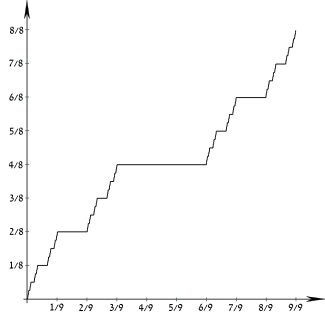Cantor distribution
|
Cumulative distribution function
| |
| Parameters | none |
|---|---|
| Support | Cantor set |
| pmf | none |
| CDF | Cantor function |
| Mean | 1/2 |
| Median | anywhere in [1/3, 2/3] |
| Mode | n/a |
| Variance | 1/8 |
| Skewness | 0 |
| Ex. kurtosis | −8/5 |
| MGF | |
| CF | |
The Cantor distribution is the probability distribution whose cumulative distribution function is the Cantor function.
This distribution has neither a probability density function nor a probability mass function, since although it is a continuous function it is not absolutely continuous with respect to Lebesgue measure, nor has it any point-masses. It is thus neither a discrete nor an absolutely continuous probability distribution, nor is it a mixture of these. Rather it is an example of a singular distribution.
Its cumulative distribution function is continuous everywhere but horizontal almost everywhere, so is sometimes referred to as the Devil's staircase, although that term has a more general meaning.
Characterization
The support of the Cantor distribution is the Cantor set, itself the intersection of the (countably infinitely many) sets:
The Cantor distribution is the unique probability distribution for which for any Ct (t ∈ { 0, 1, 2, 3, ... }), the probability of a particular interval in Ct containing the Cantor-distributed random variable is identically 2−t on each one of the 2t intervals.
Recently discovered, the Geometric Mean of all reals in the Cantor Set between (0,1] is approximately 0.274974, which is ≈ 75% of the Geometric Mean of all reals in between (0,1].[1]
Moments
It is easy to see by symmetry that for a random variable X having this distribution, its expected value E(X) = 1/2, and that all odd central moments of X except for the first moment are 0.
The law of total variance can be used to find the variance var(X), as follows. For the above set C1, let Y = 0 if X ∈ [0,1/3], and 1 if X ∈ [2/3,1]. Then:
From this we get:
A closed-form expression for any even central moment can be found by first obtaining the even cumulants
where B2n is the 2nth Bernoulli number, and then expressing the moments as functions of the cumulants.
References
- Falconer, K. J. (1985). Geometry of Fractal Sets. Cambridge & New York: Cambridge Univ Press.
- Hewitt, E.; Stromberg, K. (1965). Real and Abstract Analysis. Berlin-Heidelberg-New York: Springer-Verlag.
- Hu, Tian-You; Lau, Ka Sing (2002). "Fourier Asymptotics of Cantor Type Measures at Infinity". Proc. A.M.S. 130 (9). pp. 2711–2717.
- Knill, O. (2006). Probability Theory & Stochastic Processes. India: Overseas Press.
- Mandelbrot, B. (1982). The Fractal Geometry of Nature. San Francisco, CA: WH Freeman & Co.
- Mattilla, P. (1995). Geometry of Sets in Euclidean Spaces. San Francisco: Cambridge University Press.
- Saks, Stanislaw (1933). Theory of the Integral. Warsaw: PAN. (Reprinted by Dover Publications, Mineola, NY.
External links
- Morrison, Kent (1998-07-23). "Random Walks with Decreasing Steps" (PDF). Department of Mathematics, California Polytechnic State University. Retrieved 2007-02-16.
